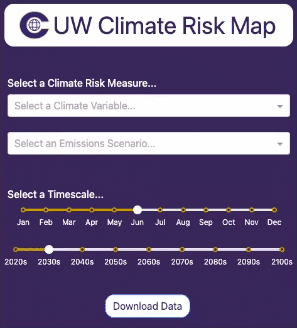CRL Map: Difference between revisions
Jump to navigation
Jump to search
mNo edit summary |
mNo edit summary |
||
| Line 18: | Line 18: | ||
*'''Select a Timescale''': Use the timeline slider to choose the time period you are interested in, ranging from the 2020s to the 2100s for all months. This lets you see how climate risks evolve over time for particular months of the year. | *'''Select a Timescale''': Use the timeline slider to choose the time period you are interested in, ranging from the 2020s to the 2100s for all months. This lets you see how climate risks evolve over time for particular months of the year. | ||
''The example on the right illustrates a scenario where the selected measure is "% Area Covered by Burnt Vegetation"—used as a proxy for wildfire risk—under a moderate emissions projection for August in the 2060s.'' | ''The example on the right illustrates a scenario where the selected measure is "% Area Covered by Burnt Vegetation"—used as a proxy for wildfire risk—under a moderate emissions projection for August in the 2060s.'' | ||
Revision as of 19:01, 7 October 2024
Welcome to the Climate Risk Map! This guide will help you get started with using the tool to understand climate-related hazards and their impacts on physical assets. Whether you're new to climate data or an experienced analyst, this guide will walk you through the basics so you can start exploring climate risk insights right away.
Getting Started
Follow this step-by-step guide for a basic overview of the map functionality. The map can be accessed here.
1. Selecting Scenario Parameters
The example on the right illustrates a scenario where the selected measure is "% Area Covered by Burnt Vegetation"—used as a proxy for wildfire risk—under a moderate emissions projection for August in the 2060s. |
